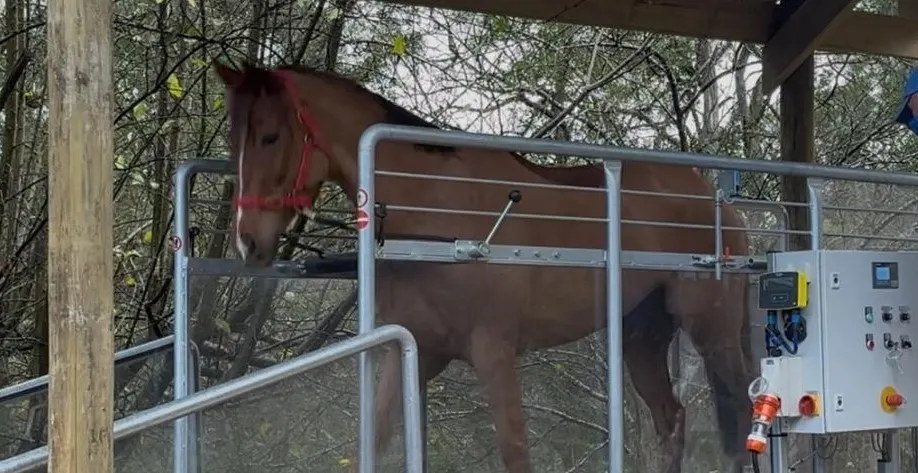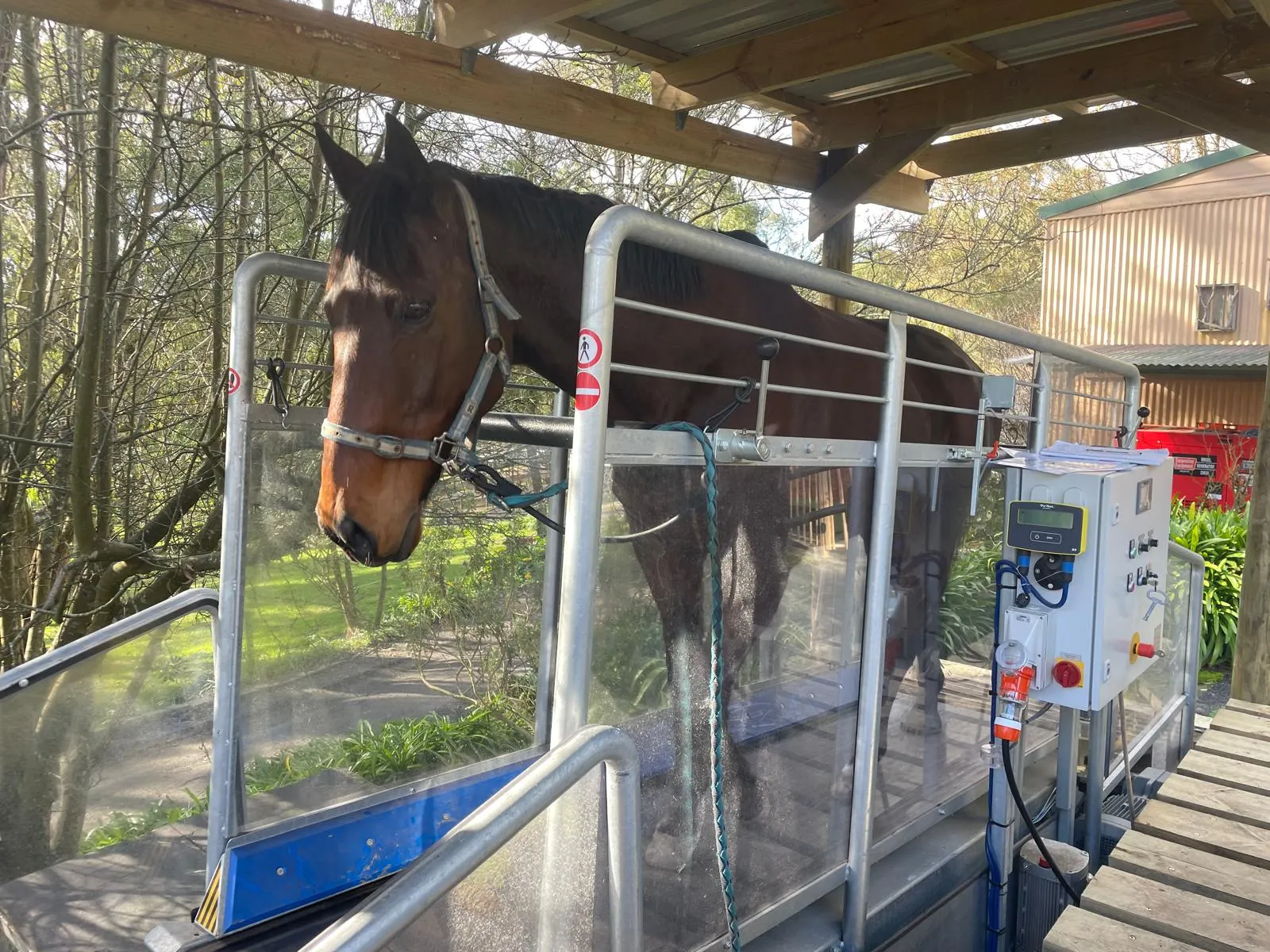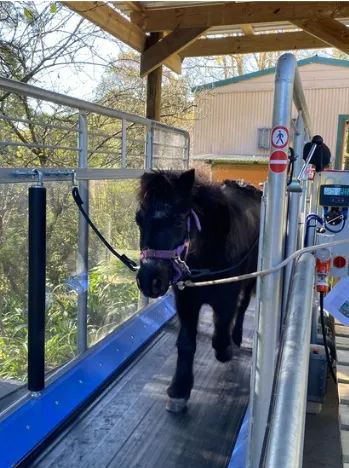The Transformative Power of the Treadmill: Building Stronger, Healthier Toplines One Step at a Time
Over the years, I’ve seen a lot of different methods used to build strength, balance and topline in horses. But one tool that continues to impress me — time and time again — is the treadmill. It’s not just for racehorses or rehab cases anymore. When used thoughtfully, the treadmill has become one of our most effective and versatile ways to develop a horse’s body in a safe, controlled and systematic way.
What amazes me most is how much difference treadmill work can make to a horse’s topline — especially when we start with slow, steady walking and then gradually introduce incline work. I’ve watched horses transform: their backs lift, their necks lengthen, their core strengthens, and their whole way of going becomes more confident and stable.
And the best part? All of this happens without the added weight of the rider or the saddle.

Why I Love Using the Treadmill
I love that treadmill training gives us complete control over speed, incline and duration. It allows me to tailor every session to suit each individual horse. Some need slower work to find their rhythm and coordination; others thrive with a slightly quicker tempo that encourages active stepping.
Every horse has their own ideal speed — the one that allows them to move freely and evenly, without rushing or dragging. On the treadmill, we can find that perfect pace and maintain it for the entire session. That kind of consistency is hard to achieve anywhere else, and it’s one of the key reasons treadmill work produces such strong, even muscle development.
By adjusting the incline gradually over time, we can strengthen the right muscles in a progressive, controlled way — never overloading or straining the horse. It’s all about building them up from the inside out.
Understanding the Topline — and Why It Matters
The topline is more than just how the horse looks. It’s the entire chain of muscles running from the poll, down along the neck, over the withers and back, right through to the hindquarters. These muscles are the foundation of posture, balance, and strength.
When the topline is well-developed:
* The back is lifted and soft.
* The horse can carry the rider’s weight comfortably.
* The movement becomes smoother, more elastic, and more expressive.
A weak topline, on the other hand, often shows up as a hollow back, tight neck, or short, uneven strides. Over time, that lack of stability can lead to soreness, imbalance and even behavioural issues under saddle and ultimately unsoundness.
That’s why I’m such a believer in building the topline from the ground up — literally. And the treadmill is one of the most effective ways to do it.
The Power of the Walk
People often underestimate how powerful walking can be as a conditioning tool. But when done with purpose — and especially when we can control the speed and add incline — the walk becomes a real strength-builder.
At the walk, every stride requires the horse to lift, balance, and engage through their entire body. By setting the treadmill speed to match the horse’s natural rhythm, we help them move evenly through the back and connect the hindquarters to the forehand.
When we add a gentle incline, even just a few degrees, everything changes.
The horse starts to:
* Step further underneath with the hind legs.
* Engage the gluteal and hamstring muscles more effectively.
* Lift through the core and topline to maintain balance.
It’s such a simple adjustment, but the results are profound. Over time, you can see the back broaden, the neck fill out, and the entire posture improve.

The Beauty of Controlled, Progressive Training
One of the greatest advantages of treadmill work is that everything happens in a controlled, repeatable environment.
We can fine-tune the incline, adjust the speed and measure progress precisely. If a horse struggles with coordination or has a weaker side, we can support them through that phase without introducing the extra variable of a rider’s weight or saddle pressure.
I’ve found that by removing those influences, horses are free to find their own natural balance. They start to straighten themselves, stabilise through the core and move with a rhythm that’s both consistent and relaxed.
When that foundation of strength and symmetry is in place, everything under saddle improves — transitions, balance, and even attitude.
Watching the Transformation
I’ve seen incredible changes in horses through regular treadmill work. Horses that used to travel with hollow backs or tight necks begin to carry themselves with more lift and lightness. They develop definition through the back and hindquarters and their stride lengthens as they gain strength and coordination.
Even more importantly, they feel different under saddle. They’re more balanced, more confident, and more willing to use their body correctly.
It’s not just physical — treadmill work seems to improve the horse’s mental relaxation as well. The steady rhythm of the belt and the consistency of the environment help them settle into a calm, focused state. Many horses that are anxious or fidgety in-hand find the treadmill soothing once they get used to it.
The Benefits Go Beyond Muscle
The topline development is the most visible change, but treadmill work also improves:
**Stability through the spine and pelvis.
**Proprioception (body awareness), helping horses track evenly.
**Joint support, as stronger muscles mean less strain on tendons and ligaments.
**Symmetry, particularly for horses that have developed one-sidedness under saddle.
Because we’re training in such a structured way, we can safely build muscle and fitness without the repetitive strain that can come from traditional arena work.
That’s why treadmill conditioning is just as valuable for leisure horses as it is for competition horses. It’s about keeping them strong, comfortable, and sound for the long term.
Building the Program
Every horse starts differently, so I always tailor the treadmill plan to the individual.
A typical progression might look like this:
**Weeks 1–2: Flat walking for 10–15 minutes at the horse’s ideal tempo.
**Weeks 3–4: Add a gentle incline (2–3°) for short intervals, alternating with flat walking.
**Weeks 5–6: Gradually increase the incline and duration as strength improves.
**Ongoing: Mix up the gradient and time to maintain challenge and variety.
Because we can track every parameter, it’s easy to see when a horse is ready for the next step. The changes are gradual but consistent — and that’s the key to building lasting strength.
Cross-Training Without the Weight
One of my favourite aspects of treadmill work is that the horse can develop strength and coordination without the added weight of the rider.
Even the best saddle and most balanced rider still add a level of load that changes how the horse moves. On the treadmill, that pressure is gone — and the horse can focus purely on correct movement and posture.
This is especially useful for:
**Young horses preparing to carry a rider.
**Older horses who need maintenance strength work.
**Rehabilitation cases rebuilding muscle after injury.
**Competition horses who need conditioning without over-stressing joints.
It’s true cross-training — a way to strengthen, condition, and support the horse’s body in a low-impact but highly effective way.
Seeing the Change Under Saddle
After a few weeks of consistent treadmill work, the difference under saddle is often remarkable.

Horses begin to:
** Move with a naturally lifted frame.
** Step through more evenly.
** Carry themselves for longer without fatigue.
** Develop a softness and stability that makes every ride more enjoyable.
Riders often comment that their horses feel lighter, straighter, and more balanced — because they are. The strength they’ve gained on the treadmill translates directly into better performance and comfort under saddle.
The Priceless Control
There’s something truly priceless about being able to control every variable in the training process.
Whether it’s pouring rain, the arena’s too deep, or the ground’s too hard, the treadmill allows training to continue in a safe, consistent way. The footing is always perfect, the conditions always predictable. For horses with sensitive joints, balance issues or inconsistent workloads, this kind of reliability makes all the difference.
It keeps the conditioning work regular and progressive — which, in my experience, is what creates the best long-term results.
A Tool for Every Type of Rider
You don’t have to be competing at a high level to see the benefits of treadmill work. For leisure riders, it’s a wonderful way to keep your horse strong, balanced and healthy — especially if you’re short on time or want to reduce the strain of schooling sessions.
For competition riders, it’s an edge. It builds the strength and posture needed for advanced work, while reducing wear and tear on the body.
The truth is, every horse can benefit from the controlled, low-impact conditioning that treadmill work provides.
My Final Thoughts
I’ve worked with horses long enough to know that there are no shortcuts to real strength and balance. It’s about thoughtful, consistent, progressive work — the kind that respects the horse’s body and allows them to develop naturally.
The treadmill is one of the most powerful tools we have to make that happen.
It allows us to build the topline, strengthen the core, improve posture and symmetry — all while keeping the horse relaxed, confident, and comfortable.
For me, that’s what good training is all about: helping the horse become the best version of themselves, in body and in mind.
So whether you’re bringing on a young horse, maintaining an older one or fine-tuning your competition partner, treadmill training is a game changer. The improvements in topline, strength, and stability speak for themselves — and once you’ve seen it, you’ll never look at the humble walk the same way again.
